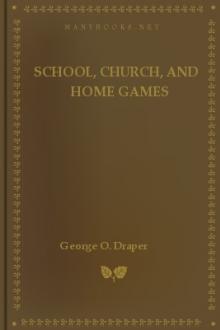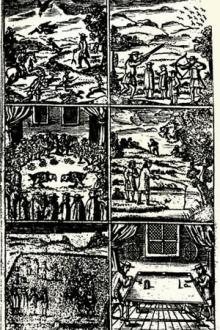School, Church, and Home Games, George Orrin Draper [best classic literature .TXT] 📗

- Author: George Orrin Draper
- Performer: -
Book online «School, Church, and Home Games, George Orrin Draper [best classic literature .TXT] 📗». Author George Orrin Draper
The captain who wins the toss can choose either the first throw or the goal he desires to have. When this is determined, each team scatters about on the territory in the vicinity of its own goal line, and the captain of the team which has the first throw designates which player on his team he desires to sling the sack first. This player (team A) must take a position with his advanced foot on the goal line and sling the sack with a straight arm over his head towards the opponent's goal line. The opponents (team B) endeavor to catch the sack before it touches the ground. Succeeding, the one catching the sack advances three paces and from that position slings the sack over his head towards team A's goal line. Team A players endeavor to catch the sack and if successful, that player succeeding advances three paces towards team B's goal line and slings the sack as before. Should any member of the team fail to catch the sack when it is thrown into their territory, the player first touching the sack in an effort to catch it, or the player nearest to where the sack lands, must make the sling from the point behind where the sack is picked up from the ground. The players may move anywhere about in their territory. The captain should endeavor to place them in a position so as to cover as much space as possible. Side boundaries can be used if desired, in which case the team supposed to receive the sack which gets out of bounds may advance three paces whether the sack is caught or not, from the point in line with where it first hits the ground.
A score is made each time the one member of a team catches the sack with both his feet on the opponent's side of the centre line. In making the catch, should he step back with one or both feet on or across the centre line, or be driven back by the impetus of the sack, it shall not constitute a point. After each point is made, goals are changed, the losing team puts the ball into play. The team having the largest score at the end of thirty minutes wins.
Game of Goose
A good sized level field should be used for this game. Two gander poles, five feet high, are erected, one at each end of the field, each having two forks at the top, opposite each other. Stout tree crotches may be used. The goose is made from a stout cloth bag, such as a ham cover, stuffed, leaving the ends which can be easily grasped. Midway between the gander poles a large circle is marked upon the ground, its size being determined by the number playing. Mark a circle six feet in diameter around each gander pole to designate the safety limit.
The group is divided into two equal teams. These two teams are arranged with their men placed alternately around the circle in the centre of the field. The gander man stands in the centre of the circle with the goose in his hand. At a given signal he swings around and tosses the goose in the air to be received in the arms of some lucky player, who immediately dashes off with it towards his goal. The opponent players endeavor to intercept him and get the goose away from him. When the man carrying the goose is in danger of losing it, he tosses it to some one on his own side, if he can, and the player catching it runs towards his goal. If the second player cannot succeed in making his goal or gander post, he tosses it on to some other member on his team. The player who succeeds in getting both feet inside of the safety circle around the gander pole must not be molested, unless he lets the goose fall to the ground in his attempt to hang it in one of the crotches of the gander pole, in which case he or his team mates may recover it or any one of the opposing team may seize the bird and dash away with it towards his own pole. There must be no scrimmage over the possession of the bird, for as soon as an opponent gets hold of the goose, the player holding the latter must let go his hold. One must not trip an opponent or interfere by body, arm, or leg contact without forfeiting one "honk." Three honks count one goose (or goal) for the opposite side.
Clock Games
The group forms a large circle. If it be a large group, the circle is counted off into 6's or 8's, if small into 4's. If they be counted into 6's each group of six constitutes a team. Number 1 in each case is to act as captain. If it be desired to elect captains, the man elected takes Number 1's place in the group. The captain wears a sash or some other distinguishing mark. In this formation a number of competitive races can be used.
Illustration—The group numbers sixty individuals. It is counted off into 6's. That means that we have ten teams of six men each making up the circle and ready to compete. The leader takes a position in the centre of the circle. The following five games may be played with the teams arranged in clock formation:
Walking Race
See clock games above.
At the signal to go, the number 6 man steps out of his place in the circle and walks to the right around the circle, until he gets back to the point in the circle he left, and tags off the Number 5 man on his team, and this man walks around the circle. This means that all the Number 5 men from all the different teams are walking around the outside of the circle in a race, at the same time. Numbers 4, 3, and 2 follow in turn after 5. Number 2, after completing the circle, tags off Number 1, the captain of the team, wearing a sash. The captain walks about the circle until he gets to the hole in the circle which he left, enters through the hole, bringing his sash to the leader, who stands in the centre of the ring. The first sash to reach the leader decides the winner of the race.
A running race can be substituted for the walking race and various modifications used, such as backward walking, hopping, frog leap, etc.
Chariot Race
See clock games above.
Similar to the preceding walking race, except that instead of running around the ring singly, the competitors go in pairs, as follows:
At the signal to go Number 6 locks his left arm in the right arm of Number 5, and the two of them so linked together proceed around the circle. Having completed the circle, Number 6 takes his original place, while Number 5 links arms with Number 4 and the two travel around the circle. Then 4 links with 3, 3 with 2, and the race ends when 2 and 1 have completed the distance around the circle and have brought their sash to the leader in the centre.
Flathead Race
See clock games above.
Similar to the preceding. A small block of wood or flat stone is given to Number 6 on each team. At the signal to go he places the block on the head of Number 5 and follows Number 5, who walks around the ring. Number 5 must keep his hands upon his hips. Should the block of wood fall from the head of Number 5, he must stand still until it has been replaced by Number 6. The two continue walking around the circle until they reach the point which they left. Then Number 6 takes his place in the circle and Number 5 takes the block from his own head and places it on the head of Number 4, and follows 4 around the ring to replace the block should it fall off. The race ends when Number 1, followed by Number 2, has completed the distance around the circle, still balancing the block of wood on his head, and presents himself to the leader in the centre.
Spin Around Race
See clock games above.
Similar to the preceding race, except that each captain takes a position about four feet outside of the circle near his own team. At the signal to go, Number 6 steps out of his position in the circle and runs to his own captain, linking his right arm in the right arm of the captain, who spins him around twice. He then runs around the circle and returns to his original place in the circle, and tags off 5, who repeats the performance of 6. When 2 has completed his round of the circle, he tags off his captain. The captain must run, without spinning around, clear around the circle on the outside, and enter through the point of the circle he originally held, and tag the leader in the middle.
Leap Frog Race
See clock games above.
Similar to the preceding. In this race, Number 2 will take the place of the captain outside of the ring. At the signal to go, Number 6 leaves the ring and proceeds around the circle, leaping with frog leaps over the backs of the Number 2 men from each team. Returning to his original position, he tags off Number 5. Number 1's turn will come after that of Number 3, and when Number 1 has completed the circle, leaping over the backs of all Number 2 men, he tags off the Number 2 of his own team. The latter runs about the circle once, enters the circle at the point where he originally stood and tags the leader in the centre.
Riding the Snail
A group is divided into two equal teams. These two teams line up in parallel lines about six feet apart, back to back. A safety line is drawn at each end of the field about twenty-five yards from where the teams line up. One team is designated as the "head" team; the other as the "tail" team. The leader tosses a coin. If the coin falls with head up, he calls "heads." Thereupon tails run across their safety line while heads endeavor to tag them before they succeed. Succeeding in doing this the man tagged has to carry the tagger upon his back to the original place of line-up and the coin is again flipped. Should it fall with tail up, tails chase heads to the safety line at the other end of the playing space.
Treasure Hunt
This game is a very adaptable one and can be run in a great number of different ways. It can be as simple or as complex as any leader may desire.
A mysterious letter may be read to the group or a letter in code posted where the group can see it. The contents of this letter will direct any one to a place where he will find detailed information as to the exact location of a buried





Comments (0)